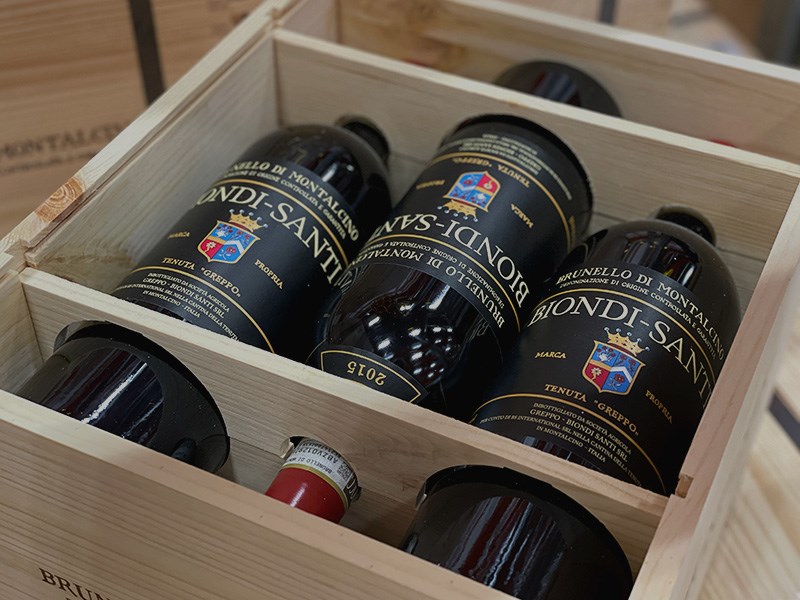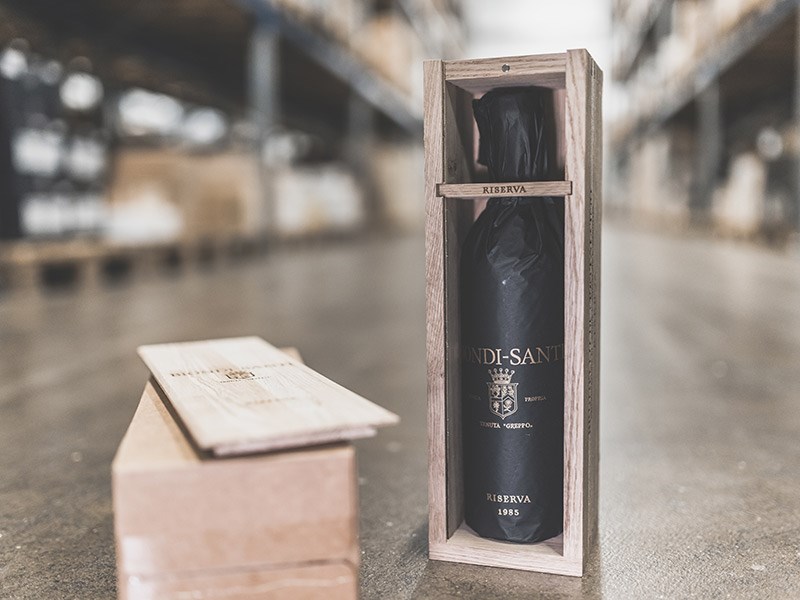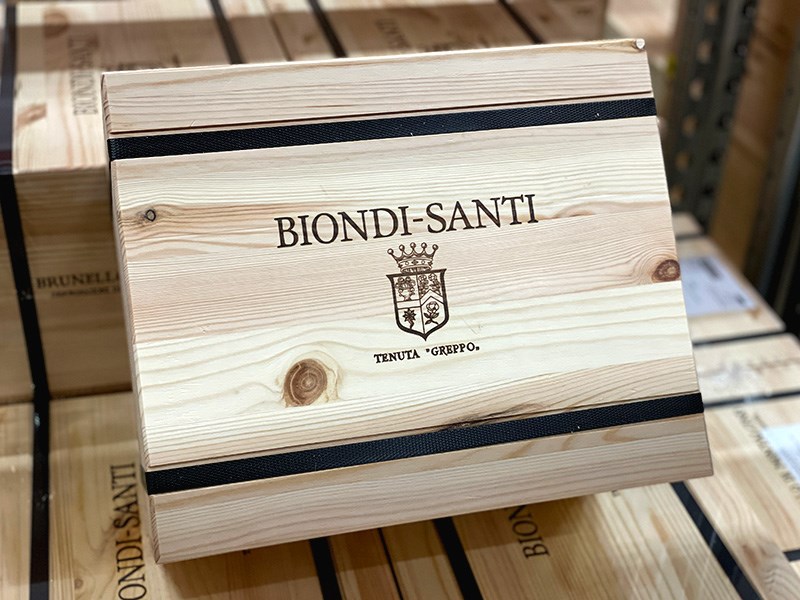Article - Italy - 16. December 2022
Biondi-Santi - The Epicentre Of The Iconic Brunello di Montalcino
Biondi-Santi is the winery where dedication, Sangiovese love, marketing, and future space travel are wonderfully intertwined. Read about the creator of Brunello di Montalcino.
Italian Tuscany is undoubtedly one of the world's most prestigious areas for the immense art of winemaking. In Tuscany you will stumble across olive groves and vineyards, and beautiful cypress avenues welcome visitors to the unique wine mecca. Val d'Orcia is one of the most beautiful gems in Tuscany - so beautiful that in 2004 the area was recognised as a UNESCO World Heritage Site. A historic town in Dal d'Orcia is Montalcino, which is undeniably a more than significant part of Tuscany's amazing wine narrative.
Montalcino, with its 16th-century surrounding wall, is in many ways a symbol of Italy's past. Churches, labyrinthine streets, and a distinctive bell tower tell the Italian story - a story filled with wine.
The Montalcino hilltop has been producing wine for hundreds of years, and in the heart of Montalcino, Tenuta Greppo is home to Biondi-Santi. Here, wines of the Sangiovese Grosso BBS 11 clone are produced from 25 hectares of vineyards. Indeed, Biondi-Santi has managed to stand out and has long since proven its place on the world's wonderful wine scene. Biondi-Santi - creator of the iconic Brunello di Montalcino.
Today, the top Italian wine is Brunello di Montalcino, along with Barolo, Bolgheri, and Barbaresco. But in the 1850s, the wine situation in Italy was significantly different. Read Biondi-Santi's wondrous story here.
Clemente Santi Placed Sangiovese On The Agenda
It is extremely rare that the origin of a wine can be traced back to a single man. However, this is the case with Brunello di Montalcino, which was created by Clemente Santi with the expert assistance of his grandson Ferruccio Biondi.
In 1865 Clemente began experimenting with the Sangiovese grape on his Tuscan estate Il Greppo. At that time, Moscato was the most widely used grape in Montalcino. Wine was not a luxury item in Italy in the 1850s - wine was an agricultural product and was looked upon as a healthier alternative to water. Wine was made throughout most of Italy, and these wines were made to be drunk throughout the year until the next harvest was in place.
Clemente was a chemist, and he had great ambitions to produce long-lasting wines with development potential. Therefore, he dedicated himself to Sangiovese and worked with different clones of the grape as well as different barrels in the cellar.
The first vintage in 1865 had brownish hues, so Clemente decided to call it "Brunello", as a reference to the colour brown (bruno), and at the Paris Exhibition in 1867 the wine was noted precisely for its beautiful brown colour. Clemente Santi put Sangiovese on the agenda, and fortunately his grandson Ferruccio picked up on that agenda.
 Biondi-Santi Riserva
Biondi-Santi Riserva
Dr. Ferruccio Biondi Santi From Montalcino - The Creator Of Brunello
Ferruccio Biondi, like his grandfather, was very passionate about Sangiovese, and so he continued to experiment in the vineyards. He worked diligently to identify parent vines, then grafted the best clones onto American rootstocks. At the end of this process, he replanted his vineyard with the progeny of the parent clones and propagated what would later become the Brunello Biondi-Santi clone BBS 11.
Ferruccio focused on creating a Sangiovese clone that could withstand the Phylloxera vine aphid, which unfortunately dominated and ravaged the area. He succeeded.
This resulted in the identification of a superior Sangiovese clone, which was highly resistant to plant diseases. He also managed to stay true to his grandfather's vision of focusing on durability rather than quick profit, and the decision to bottle a 100 % Sangiovese wine was both bold and unprecedented. Ferruccio built on his grandfather's genius and can be credited with the first two vintages of Biondi-Santi Brunello di Montalcino - 1888 and 1891.
It was Ferruccio, moreover, who united the two family names, and it was he who decided that the Sangiovese wine should be called Brunello di Montalcino, and no Brunello producer has managed to achieve the same high level. Ferruccio's vision was highly revolutionary for its time, and in 1932 the Italian Ministry of Agriculture officially recognised Ferruccio Biondi Santi as the inventor of Brunello di Montalcino.
With Tancredi Came The Rise Of Brunello
Clemente and Ferruccio created a solid and revolutionary foundation on which Tancredi Biondi Santi could gain a solid base and continue the Brunello mission. For in 1893 Ferrucio had a son named Tancredi, and he would go on to play a very important role in bringing Brunello to a wider audience.
Tancredi grew up among vines and in 1922 he took over Biondi-Santi from his father. Above all, Tancredi was an eminent winemaker, and in 1927 he developed the Biondi-Santi topping-up technique (filling the empty air space at the top of the wine bottle), which he applied to the estate's historic wines to ensure their preservation.
Besides being a formidable winemaker, Tancredi also understood the importance of cohesion with product and marketing. Biondi-Santi never patented the Brunello di Montalcino brand, purely because they did not want to restrict others from making Brunello. This, of course, led to more and more people becoming aware of Brunello, and therefore Biondi-Santi.
Furthermore, in 1969, the President of the Italian Republic, Saragat, wanted six bottles of 1955 Brunello di Montalcino to serve to a young Queen Elizabeth, prompting massive Biondi-Santi publicity. Tancredi is therefore often described as the most significant cause of Biondi-Santi and Brunello's worldwide fame.
Franco Maintained The Traditions Created By His Ancestors
”Nature is capable of creating great things, you just have to know how to wait”
– Franco Biondi Santi
Having a grandfather who invented the Brunello and a father who introduced it to the market seriously makes a man feel obliged. Tancredi's son Franco Biondi Santi became gatekeeper of Biondi-Santi in 1970, and his mission was to keep the traditions, create wines for the future and fight for the authenticity and integrity of Brunello di Montalcino. Franco was both reverent and thorough. So thorough, in fact, that he was a member of the Florentine scientific society Accademia dei Georgofili. Here his opinions were deeply respected.
Under Franco's leadership of Biondi-Santi, there were several events that further sharpened the focus on the house. In 1988, for example, he served a bottle of 1888 Brunello Biondi-Santi Riserva to Italian President Francesco Cossiga, which naturally attracted attention. Furthermore, in 1994, Franco organised a much-publicised press tasting of Brunello Riserva from 1888 to 1988 to mark Brunello's 100th anniversary.
Traditionally, Franco's son Jacopo was to take over Biondi-Santi, but for unknown reasons there was a disagreement between the two, and Jacopo partially left the house and started Montepò instead. Jacopo's son Tancredi was therefore supposed to continue managing Biondi-Santi, but he too decided to leave the family business in part to help his father. At Franco's death in 2013, there was therefore no fully dedicated helmsman to take up the Brunello baton.

EPI Group Neatly Picks Up The Family Baton
In 2017, Christopher Descours from the private investment firm EPI Group acquired a large stake in Biondi-Santi - albeit with both Jacobi and Tancredi on board. In 2019, however, Jacobi decided to leave Biondi-Santi for good, and in 2020 Tancredi followed suit. The family is therefore no longer involved at Biondi-Santi, but there is no slackening in quality for that reason.
EPI has extensive experience in marketing luxury brands and is in fact also behind strong names such as Piper-Heidsieck, Charles Heidsieck & Rare Champagne, Sogrape from Portugal and most recently Isole e Olena from Chianti Classico, all of which have benefited greatly from competent ownership.
The EPI group chose to continue with the winemakers Federico Radi in the cellar and vineyard. With EPI at the helm, one thing is certain: Marketing and distribution will be a priority, and these focal points obviously require a product of the highest quality. Small but significant changes have been introduced, making the wines slightly more accessible in their youth, though still maintaining the traditional production of Brunello di Montalcino. And based on the ratings of the top wine critics, the level of the future only seems to be rising.
Brunello di Montalcino: The Rules
There are a number of rules that have to be respected before a wine can even be called Brunello. A Brunello is made from Sangiovese from Montalcino's 1,200 hectares of planted vines. According to the rules, a maximum of 52 hectoliters per hectare can be produced. Furthermore, there are also rules on when a Brunello can be released on the market - it can be on 1 January five years after the harvest.
During the five-year period, two of these must be spent in wooden barrels, and four months must be spent in bottle before release. A Riserva may not be released until six years after the harvest and must age for at least six months in bottle.
At Biondi-Santi, the procedure for making Brunello has not changed for more than 100 years. The vineyards are cultivated with great respect for nature, without the use of chemicals. Only one pure Sangiovese clone is used (BBS 11) and the wine is still aged in part in the same large barrels Ferruccio acquired over 100 years ago.
In 1980 Brunello di Montalcino was elevated to the highest classification in Italy with DOCG (Denominazione di Origine Controllata e Garantita), for which the area in many ways owes a debt to Biondi-Santi. By this time the number of producers had increased from one with Biondi-Santi in the period from 1865 to 1945 to now 53 registered producers.
Several of these had ambitions to change the way Brunello di Montalcino is made, and over the years small barrels, modified fermentation methods and new grape varieties have been tried. Even with Federico Radi's small changes, however, Biondi-Santi faithfully adheres to the method Ferruccio introduced 100 years ago.
The Three Gems From Biondi-Santi
Today, Biondi-Santi produces three red wines from their own clone of Sangiovese, called BBS 11, which stands for Brunello Biondi-Santi Vine 11. In 1970, Franco Biondi Santi collaborated with Professors Casini and Bandinelli of the Arboreal Cultivation Institute at the University of Florence on a clonal selection of Ferruccio's old Greppo vines. After five harvests, several Sangiovese clones were selected, but the one officially entered in the EU register was BBS 11. It was included in the official list of Sangiovese clones in 1978 and is the first to bear the name of its owner.
From this Sangiovese Grosso BBS 11 clone emerges the historic Riserva Brunello di Montalcino, the classic Brunello di Montalcino and a fine Rosso di Montalcino.
Rosso di Montalcino
Biondi Santis Rosso di Montalcino has always been a special wine for the house. It was created with the desire to make a red wine that reflects the characteristic style found in Biondi-Santis vineyards. It was originally known as White Label Brunello di Montalcino by Biondi-Santi until 1983, when Rosso di Montalcino became the definitive name.
Rosso is produced from the youngest vines in the house, and today it is aged for a shorter time than the Brunello di Montalcino - only 12 months in large barrels. This is to preserve more immediate fruit in the wine, making it enjoyable even at a young age. Rosso di Montalcino is a high-level wine, and it deservedly competes with other houses' Brunello di Montalcino in complexity and depth.
The Flagship - Brunello di Montalcino
Brunello di Montalcino Annata is the flagship wine of Biondi-Santi - it is the pride of the family put into bottles. This is the wine that captures the essence of more than 150 years of hard and dedicated work in one bottle. The wine is fermented in cement tanks before being aged for three years in large old Slavonian oak barrels. This Brunello develops beautifully with long aging in bottle.
It is produced using the same method as the Riserva - the only difference is that the hand-picked grapes come from vines that are between 10 and 25 years old. This is the age at which vines usually perform optimally in terms of both quantity and quality. In the years when Biondi-Santi does not choose to produce Riserva, the grapes from the old vines also go into this wine.
Biondi-Santi Brunello di Montalcino comes on the market in most vintages. The vintages where the weather does not behave, the wine is not released.
"It's a matter of seriousness, which is part of our history, when the vintage goes wrong, we do not make Brunello di Montalcino”, Jacopo Biondi
2014 is the last time the house chose not to release a Brunello di Montalcino - it has previously happened in both 2002 and 1989. Normally, 2/3 of the grapes go to the Brunello of the house, and the last third is divided between the Rosso and the Riserva of the house. In the three vintages where the quality has not been good enough for Brunello, Biondi-Santi has used them instead for their Rosso.

Brunello di Montalcino Riserva
Brunello di Montalcino Riserva is the wine that has historically characterized the winery and has only been produced in the 41 best vintages since the historic 1888 vintage. The grapes come from the oldest vines on the estate, all over 25 years old. The wine is aged for three years in large old slavic oak barrels - in previous vintages the wine was aged for up to four years in these old barrels. Some of the barrels are more than 100 years old, as the view at Biondi-Santi is that the wine does not need the flavours that new wooden barrels can add.
Biondi-Santis Riserva is one of the great icons of the wine world, which is why it is also celebrated in style at the house, the years the grapes have the quality that a Riserva requires. Biondi-Santi believes that the Riserva is a gift from Mother Earth, and this is certainly worthy of celebration. Kept in optimal conditions, a Biondi-Santi Riserva has an almost infinite life. For example, the family enjoyed a bottle in 1891 to celebrate Franco Biondi Santi's 60th wedding anniversary.
In 1999, the 1995 Brunello di Montalcino Biondi-Santi Riserva was named by Wine Spector as one of the 12 best wines of the 20th century. In 2008, the 2001 Riserva was ranked in the top-3 of Decanter's list of the 50 best Italian wines, and in 2011 the 1964 Riserva received the Bibenda 2012 award from The Italian Association of Sommeliers as the best wine in Italy's history.
Wine Library La Storica
Deep in the cellar far from humanity below Tenuta Greppo is La Storica, which is Biondi-Santi's wine library. A library where a library card is unlikely to be accepted. La Storica is in fact Biondi-Santi's own library, where they keep their reserves and where Riserva from all vintages can be found. It is an intimate place where the bottles are neatly stacked and divided by vintage. Besides beeswax, which seals the cork and minimizes oxidation, the bottles are completely bare.
It is from La Storica that Biondi-Santi finds the bottles to top it off. Several of the old bottles have been re-corked and topped up with the same vintage. A cork can only last for about 30 years, after which there is a great danger of it crumbling and thus spoiling the wine. A wine is therefore re-corked in order to keep it in optimal condition - and thus achieve utopian immortality.
It is rare that a Riserva is released from a stay at La Storica. When it does, the otherwise bare bottle is given a label with the vintage designation and the numbered neck label called "La Lunetta". Furthermore, the date of departure is handwritten on the label on the back of the bottle. If a Riserva has been topped up or recorked, a special certificate accompanies the bottle - to indicate that the procedure has taken place.
The Future: Biondi-Santi In Space
Although the Biondi Santi family is no longer present in Biondi-Santi, the traditional production of Brunello is maintained, although small adjustments are made. Adjustments that seem to pay off and result in wines that reap great reception from critics and wine romantics alike. Today, Biondi-Santi is widely recognized among the very best wines from Italy.
And while constantly striving to deliver high quality Brunello, there are also other exciting developments going on at Biondi-Santi.
Biondi-Santi is one of three wineries collaborating with The Italian Space Agency and The Italy Sommelier Foundation (FIS) on a project to study the ageing process of wine and the ability of vine plants to produce crops in space. This means that a selection of vines and wine bottles from the three participating wineries will spend a period of 2-3 years in space aboard the International Space Station (ISS). When they return to Earth, they will be compared with samples that stayed on Earth.
The Italian Space Agency is leading research on the effects of lack of gravity on crops, and this will be the first time they study wine and grapes. Indeed, previous similar experiments with gravity have shown that cuttings are more resistant to parasite attack and the effects of climate change if they have been exposed to some kind of shock, such as loss of gravity.
Similar projects have been executed before by Space Cargo Unlimited in collaboration with 2000 Petrus and 320 vines, which were in space for 14 months. Biondi-Santi is sending the 2006 and 2015 Brunello di Montalcino vintages into space - when the project will take place is still uncertain. It is also uncertain whether Clemente, Tancredi, Ferruccio and Franco would have approved of the space idea... What is certain, however, is that Biondi-Santi is both traditional and forward-looking.
